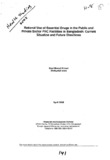| dc.contributor.author | Ahmed, Syed Masud | |
| dc.contributor.author | Islam, Shafayetul | |
| dc.date.accessioned | 2019-11-28T05:01:33Z | |
| dc.date.available | 2019-11-28T05:01:33Z | |
| dc.date.issued | 2008-04 | |
| dc.identifier.citation | Ahmed, S. M., & Islam, S. (2008, April). Rational use of essential drugs in the public and private sector PHC facilities in Bangladesh current situation and future directions. Research Reports (2008): Health Studies, Vol - XL, 141–167. | en_US |
| dc.identifier.uri | http://hdl.handle.net/10361/13146 | |
| dc.description.abstract | In Bangladesh, the National Drug Policy (NDP) of 1982 was instrumental in improving
the supply of quality essential drugs at an affordable price, especially in the early years
However, over time, evidences exist about the deterioration of situation both in terms
of availability of essential drugs as well as rational Lise of drugs. This study examined
the current status of the outcome objectives of the NDP in terms of availability,
affordability and rational use of drugs in the primary healthcare (PHC) facilities in
Bangladesh. To address this, the study covered a random sample of Upazila Health
Complexes (UHC) in the rural areas (n=30) and a convenient sample of Urban Clinics
(UC) in the Dhaka Metropolitan area (n=20) for observation, exit-interview and minimarket
survey to collect data on WHO core drug use indicators in health facilities.
Findings reveal the availability of essential drugs for common illnesses to be poor,
varying from 6% in the UHCs to 15% in the UCs. Drugs dispensed out of total
prescribed was higher in UHCs (76%) compared to lJCs (44%). Dispensed drugs were
not labeled properly, though 73% of the patients/care-givers reported to have
understood the dosage schedule. Copy of an Essential Drugs List was available in
55% UCs and 47% UHCs with around 2/3rd drugs being prescribed from it.
Polypharmacy was higher in the UCs (46%) than in the UHCs (33%). An antibiotic was
prescribed in 44% of the encounters, more frequently for fever (36-40%) and common
cold (26-34%) than for lower respiratory tract infection including pneumonia (10-20%).
Prices of key essential drugs differed widely by brands (500% or more), seriously
compromising the affordability for common people. 'This, the availability, affordability
and the rational use of drugs have remained an illusory target to achieve in
Bangladesh even 27 years after passing the much acclaimed NDP of 1982. | en_US |
| dc.language.iso | en | en_US |
| dc.publisher | BRAC Research and Evaluation Division (RED) | en_US |
| dc.subject | Rational use of drugs | en_US |
| dc.subject | National Drug Policy 1982 | en_US |
| dc.subject | Bangladesh | en_US |
| dc.subject.lcsh | Drugs -- Prescribing. | |
| dc.subject.lcsh | Drug utilization. | |
| dc.subject.lcsh | Pharmaceutical services -- Developing countries. | |
| dc.subject.lcsh | Primary health care -- Bangladesh. | |
| dc.title | Rational use of essential drugs in the public and private sector PHC facilities in Bangladesh current situation and future directions | en_US |
| dc.type | Research report | en_US |

